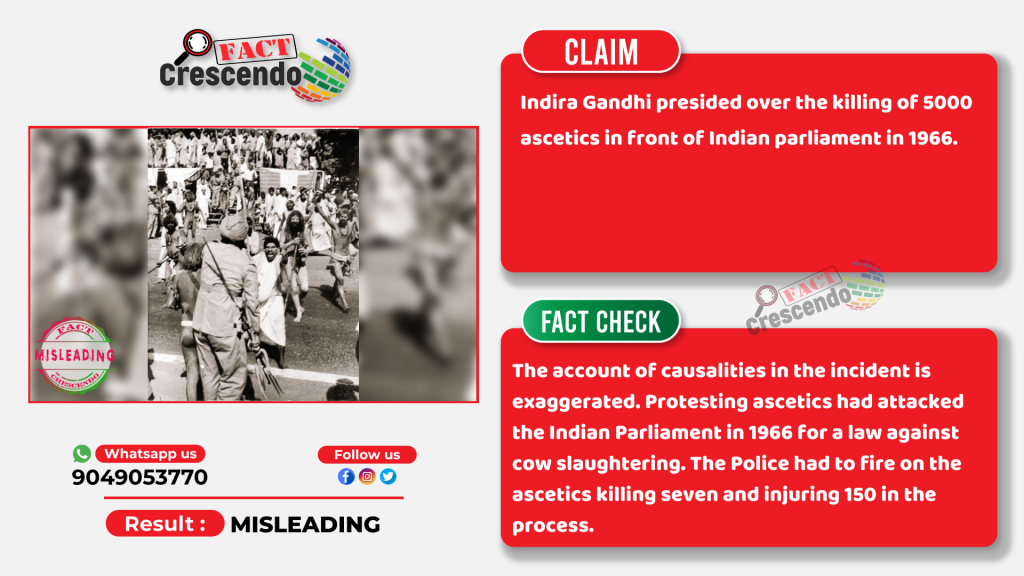
Prime Minister Narendra Modi inaugurated the new building of the Indian Parliament last Sunday. This event was mired with a number of controversies, ranging from the boycott of the event by 20 opposition parties, the installation of Sengol as the symbol of power and the arrest of wrestlers protesting against WFI chief Brij Bhushan Sharan Singh.
Wrestlers Vinesh Phogat, Sakshi Malik, and Bajrang Punia were among the wrestlers who were arrested by the police for protesting in front of the Parliament on Sunday. This event triggered massive outrage, and people condemned the government for treating the athletes in such a way. Prominent personalities who called out the government for this mistreatment of Indian wrestlers included Indian football legend Sunil Chhetri, Olympic gold medalist Neeraj Chopra, and World Cup-winning former Indian cricketer Irfan Pathan.
Following this massive outrage on social media, many came in favor of the government and cited the example of Indira Gandhi. They alleged that the former Prime Minister Indira Gandhi presided over the ‘massacre of 5000 Hindu ascetics’ in 1966. One such tweet by BJP leader Abhijat Mishra can be seen below.

View Tweet here – Twitter | Archived Link
While countering the charges made by INC President Mallikarjun Kharge against the BJP-RSS, Mishra asks Kharge about the 1984 Anti-Sikh riots and the 1975 Emergency. In the process, he also accuses the Congress of carrying out the massacre of Hindu Sadhus in 1966. Similar posts are spreading on other social media platforms as well. Here is a post from Facebook making similar allegations against the then Prime Minister Indira Gandhi.

The above post compares the 1966 incident with Jalianwala Bagh massacre and claims 5000 Sadhus were killed during the firing. An OpIndia article from 2020 also makes the same claim. The article claims that official records have been severely underestimated and 5000 ascetics have were murdered.
Let us find out what actually happened on 7 November 1966 and how many seers were killed in the clashes between protestors and the police.
Fact Check
We conducted a Google search to learn more about the incident. During our investigation, we discovered that this claim is not new and has been circulating for many years. In 2018, BBC did a detailed article debunking this misinformation and clarified that reports suggest only seven people died in the clashes in contrast to 5000 claimed in the viral posts.
The BBC interviewed eminent historian Harbans Mukhiya, who recalled the protests as follows: ‘The 7 November (1966) incident was neither a protest nor a movement but is considered to be an organized rampage. The ruckus was forgotten as quickly as it took to organize it.’ The views of Mukhiya are also echoed by veteran journalist and author Dhirendra K. Jha in his book, Ascetic Games: Sadhus, Akharas and the Making of the Hindu Vote. In his book, he describes the 7 November incident as follows: A Vaishnav Sadhu, Prabhudutt Brahmachari who lost elections to Pandit Jawaharlal Nehru was behind this protest. He along with the Vishwa Hindu Parishad (VHP) launched a campaign against cow slaughter. On 25 September 1966, SGMS (Sarvadaliya Gauraksha Mahabhiyan Samiti) was formed under the leadership of Prabhudutt Brahmachari and it included RSS, the Hindu Mahasabha, Ramrajya Parishad, Arya Samaj and Sadhu Samaj along with traditionalist Congress leaders like then Home Minister Gulzarilal Nanda. Under the leadership of Prabhudutt Brahmachari, more than a lac Sadhus tried to storm the Indian Parliament on 7 November 1966. They demanded a legislation banning cow slaughter in India. However, the police had to resort to firing after lathicharge and teargas shelling failed to control them. In this firing, seven people died and 140 were injured.
Dhirendra K. Jha’s account of seven causalities are supported by the contemporary newspaper reports. On 8 November 1966, The Hindu reported on the incident with the headline, ‘Anti-cow slaughter mob storms Parliament’. The report says, “Curfew was imposed on the Union territory of Delhi to-day [Nov. 7] after anti-cow slaughter demonstrators numbering many thousands stormed Parliament House and indulged in unprecedented acts of violence, burning parked cars and setting fire to Central Government buildings. Police guarding Parliament House opened fire on the yelling mob. According to official sources, seven persons were killed and over 100 injured in the violent incidents. Mr. G.L. Nanda, Home Minister, reported to the Lok Sabha on the incidents.”
The Indian Express also reported the death of seven people and the injured as 200. You can see the screenshot of the front page of The Express reporting the 7 November incident on 8 November 1966.

The Army was alerted and a curfew was imposed in Delhi on the same day following the incident. Thus, the claims of 5000 Sadhus were killed seem to be extremely exaggerated as there are no reports or evidence to support them.
Does it really matter if only seven people were killed instead of 5000?
Some may argue that the number of casualties is inconsequential in this case. However, grossly inflating the death toll in the 7 November 1966 incident represents a significant distortion. This distortion aligns with the concept of the Big Lie, a propaganda tool employed by Adolf Hitler and his associates to manipulate the minds of the German population.
Similarly, the distortion of accounts surrounding the 7 November incident serves a similar purpose. The terms ‘genocide’ or ‘massacre’ are being used due to the significantly reported number of 5000 casualties. This flagrant misrepresentation not only distorts the facts but also misleads individuals who lack the complete context of the incident.
While any loss of life is tragic and condemnable, the exaggerated death toll aims solely to provoke negative sentiments against the then Congress government. Moreover, this distorted figure enables an inaccurate comparison between the incident of protestors attempting to storm the Indian Parliament and the Jallianwala Bagh massacre, where General Dyer ruthlessly murdered innocent people who were peacefully celebrating Baisakhi.
Conclusion
The number of 5000 ascetics dying in police firing during the protest in front of the Indian Parliament on 7 November 1966 is immensely exaggerated. The reports and various historical accounts indicate the actual number of people who died in the incident to be seven. The Police were forced to open fire on the ascetics when they tried to storm the Indian Parliament.

Title:The Complete Truth of the 1966 Protests Outside the Indian Parliament Demanding Anti-Cow Slaughter Legislation, Led by Sadhus
Written By: Harish Nair
Result: Misleading

Stay connected with us on social media platform for instant update click here to join our Twitter, & Facebook
We are now on Telegram. Click here to join our channel (@TechiUpdate) and stay updated with the latest Technology headlines.
For all the latest Fact Check News Click Here
